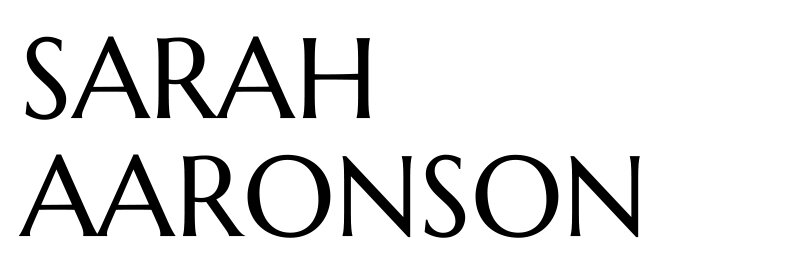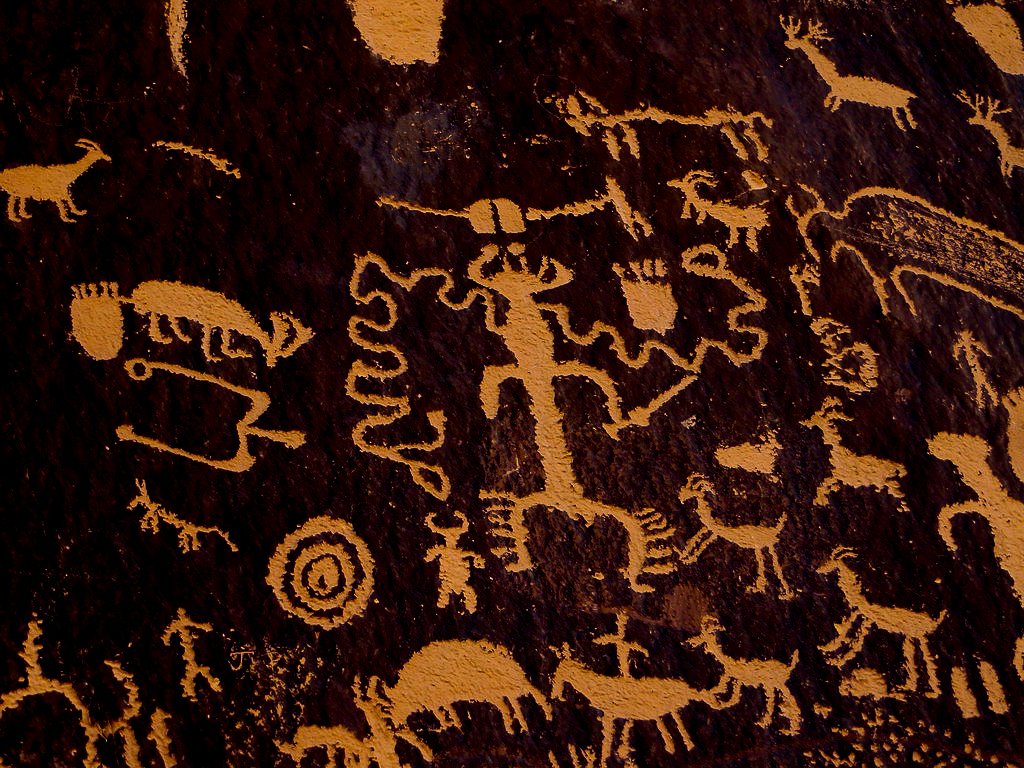ROCK PAPER SCISSORS
Keith Haring in His Studio • 1983 • Allan Tannenbaum
How Keith Haring’s collaborative graphics and textiles for Malcolm McLaren & Vivienne Westwood’s 1983 Witches collection fittingly resembled the ancient petroglyphs carved on Newspaper Rock... Haring’s graphics, resembling a sort of hieroglyphic graffiti, were wonderfully similar to the vibrant carvings found in San Juan County, Utah. The Archaic, Anasazi, Fremont, Navajo, Anglo, and Pueblo cultures created these images during both the prehistoric and historic periods. Depicting over 650 rock art designs featuring animals, human figures, and symbols, it has been suggested that the rock was used as a communication hub amongst travelers. In Navajo, the rock is called Tse' Hone which translates to a rock that tells a story, much like the subversive messages Haring expressed through his art and Westwood and McLaren conveyed through their textiles…
Worlds End Diablo Sweater made in collaboration with Keith Haring • Autumn / Winter 1983 Witches Collection • Vivienne Westwood & Malcolm McLaren • Private Collection
Newspaper Rock Petroglyphs • 1st Century - 14th Century A.D. • Newspaper Rock State Historic Monument • San Juan County, Utah
Pop Shop Flyer • 1985 • Keith Haring • Image courtesy of Swann Auction Galleries
The diabolical hip hop styling of the collection featured neon graffiti hues, devilish white trainers customized with three tongues and primitive pagan graphics such as the Diablo print which included multiple representations of the devil’s name and a dog-headed figure for example... Curiously, McLaren believed the notion that authenticity and magic existed only in ethnic, pre-Christian, pre-industrial cultures. Witches was the ideal convergence of Haring’s modernly primitive designs, McLaren’s references to those who practice witchcraft, zombies, medicine men, dog-headed people and the devil, inspired from Jean Kerboull’s book Voodoo and Magic Practices, and Westwood’s brilliant experimentation with drape and cut. It is now considered one of the most influential and significant fashion collections of the 20th Century, especially when considered as a precursor to the giant that streetwear has become today.
Untitled • Marker on Taxi Hood • 1982 • Keith Haring with LA II (Angel Ortiz) • Image courtesy of Keith Haring by Keith Haring
“The Witches Collection of Autumn / Winter 1983 was Vivienne Westwood and Malcolm McLaren’s final collaboration for their label World's End before Westwood started her eponymous fashion label. It came following a trip to America to meet Keith Haring, whose fluorescent, graffiti-inspired designs would feature on a number of the pieces. The collection was influenced by Haring’s ‘magical, esoteric sign language’ (which also inspired its eerie name) and early-1980s American hip-hop culture.” • Courtesy of The V&A
Newspaper Rock Petroglyphs • 1st Century - 14th Century A.D. • Newspaper Rock State Historic Monument • San Juan County, Utah
Runway models for the Witches show • March 21, 1983 • Cour Carrée du Louvre • Paris • Image courtesy of CATWALK Vivienne Westwood : The Complete Collections by Alexander Fury
Newspaper Rock Petroglyphs • 1st Century - 14th Century A.D. • Newspaper Rock State Historic Monument • San Juan County, Utah
Untitled • 1983 • Keith Haring with Kermit Oswald • Schorr Family Collection • Image courtesy of Keith Haring by Keith Haring
Newspaper Rock Petroglyphs • 1st Century - 14th Century A.D. • Newspaper Rock State Historic Monument • San Juan County, Utah
One of four Worlds End blankets made by Keith Haring for the Worlds End show • December 1982 • Image courtesy of Rago
Untitled • Collection of Ink on Terracotta Vases • 1984 • Keith Haring • Image courtesy of Keith Haring by Elisabeth Sussman in association with the Whitney Museum of American Art, New York City
Newspaper Rock Petroglyphs • 1st Century - 14th Century A.D. • Newspaper Rock State Historic Monument • San Juan County, Utah
Runway model for the Witches show • March 21, 1983 • Cour Carrée du Louvre • Paris • Image courtesy of CATWALK Vivienne Westwood : The Complete Collections by Alexander Fury
Worlds End Diablo Sweater made in collaboration with Keith Haring • Autumn / Winter 1983 Witches Collection • Vivienne Westwood & Malcolm McLaren • The Costume Institute • The Metropolitan Museum of Art, New York CIty
Untitled • 1983 • Keith Haring with Kermit Oswald • Private Collection • Image courtesy of Keith Haring by Keith Haring
Newspaper Rock Petroglyphs • 1st Century - 14th Century A.D. • Newspaper Rock State Historic Monument • San Juan County, Utah
Untitled • Ink on Terracotta Vase • 1984 • Keith Haring • Image courtesy of Keith Haring by Elisabeth Sussman in association with the Whitney Museum of American Art, New York City
Poster created for the Keith Haring's second exhibition at the Shafrazi Gallery • 1983 - 1984 • Keith Haring
Worlds End Diablo Sweater made in collaboration with Keith Haring • Autumn / Winter 1983 Witches Collection • Vivienne Westwood & Malcolm McLaren
Untitled • 1981 • Keith Haring • Brant Foundation • Image courtesy of Keith Haring by Elisabeth Sussman in association with the Whitney Museum of American Art, New York City
Keith Haring posing amongst his work • Circa 1986
Newspaper Rock Petroglyphs • 1st Century - 14th Century A.D. • Newspaper Rock State Historic Monument • San Juan County, Utah
Detail of Worlds End Diablo knit made in collaboration with Keith Haring • Autumn / Winter 1983 Witches Collection • Vivienne Westwood & Malcolm McLaren
Worlds End Diablo Skirt made in collaboration with Keith Haring • Autumn / Winter 1983 Witches Collection • Vivienne Westwood & Malcolm McLaren • The Costume Institute • The Metropolitan Museum of Art, New York CIty
Untitled • 1982 • Keith Haring • Neumann Family Collection • Image courtesy of Keith Haring edited by Germano Celant
Keith Haring in his studio in New York City • November 20, 1983 • Paulo Fridman
Newspaper Rock Petroglyphs • 1st Century - 14th Century A.D. • Newspaper Rock State Historic Monument • San Juan County, Utah
Have My Doodles • December 1986 • Keith Haring • Image courtesy of EJ's Auction & Appraisal
Newspaper Rock Petroglyphs • 1st Century - 14th Century A.D. • Newspaper Rock State Historic Monument • San Juan County, Utah
Keith Haring at his Pop Shop in New York • Circa 1986
Madonna modeling a Keith Haring print knit skirt from the Worlds End Witches collection • 1984 • Eric Watson • National Portrait Gallery, London
Record cover artwork for the 1983 vinyl 7” single Duck For the Oyster featuring a portrait of Malcolm McLaren adorned with an illustration by Keith Haring
Keith Haring photographed in front of his Crack is Wack mural • 1986 • East Harlem • Owen Franken
Cartographic Map of the Petroglyphs of Newspaper Rock • James Q. Jacobs
Young Kim wearing an ensemble from the Autumn / Winter 1983 Witches Collection made in collaboration with Keith Haring • Image courtesy of Jean-François Carly via Dazed Digital
Invitation to the Autumn / Winter 1983 Witches Show • Image courtesy of Vivienne Westwood by Claire Wilcox
Newspaper Rock Petroglyphs • 1st Century - 14th Century A.D. • Newspaper Rock State Historic Monument • San Juan County, Utah
Untitled • 1981 • Keith Haring • Schorr Family Collection • Image courtesy of Keith Haring by Keith Haring
Worlds End Diablo Sweater made in collaboration with Keith Haring • Autumn / Winter 1983 Witches Collection • Vivienne Westwood & Malcolm McLaren • Powerhouse Museum, Sydney
Untitled • 1981 • Keith Haring • Schorr Family Collection • Image courtesy of Keith Haring by Keith Haring
Untitled • Marker Ink on Leather • Circa 1983 • Keith Haring with LA II (Angel Ortiz)
Runway model for the Witches show • March 21, 1983 • Cour Carrée du Louvre • Paris • Image courtesy of CATWALK Vivienne Westwood : The Complete Collections by Alexander Fury
Newspaper Rock Petroglyphs • 1st Century - 14th Century A.D. • Newspaper Rock State Historic Monument • San Juan County, Utah
Runway model for the Witches show • March 21, 1983 • Cour Carrée du Louvre • Paris
Newspaper Rock Petroglyphs • 1st Century - 14th Century A.D. • Newspaper Rock State Historic Monument • San Juan County, Utah
Worlds End label of a Diablo knit made in collaboration with Keith Haring • Autumn / Winter 1983 Witches Collection • Vivienne Westwood & Malcolm McLaren
Keith Haring Drawing on Glass • Circa 1987 • Image courtesy of Muna Tseng Dance Projects, Inc.
Model wearing a Worlds End ensemble from the Witches collection
Untitled • 1982 • Keith Haring with LA II (Angel Ortiz) • Image courtesy of Keith Haring edited by Germano Celant
Newspaper Rock Petroglyphs • 1st Century - 14th Century A.D. • Newspaper Rock State Historic Monument • San Juan County, Utah
Malcolm McLaren, Talisa Soto and Vivienne Westwood modeling Worlds End ensembles from the Witches collection • June 1, 1983 • Vogue • Steven Meisel




















































